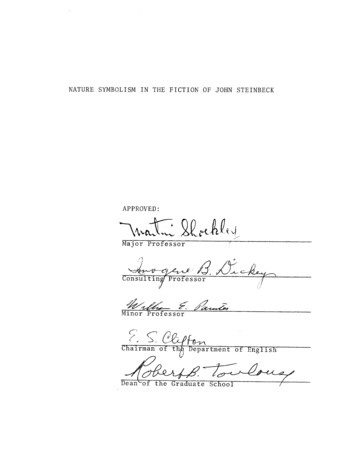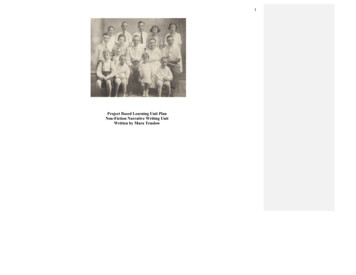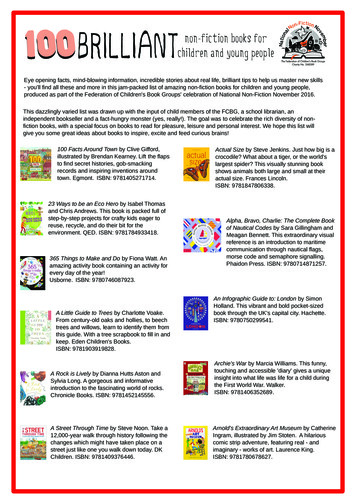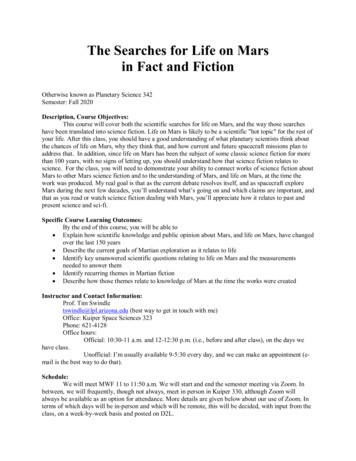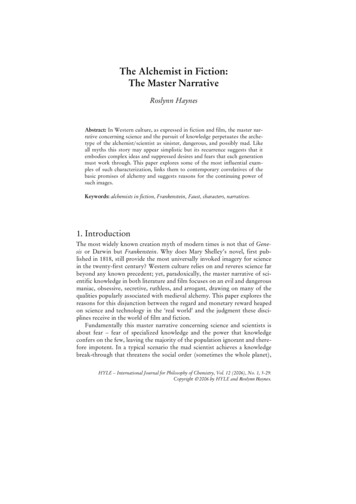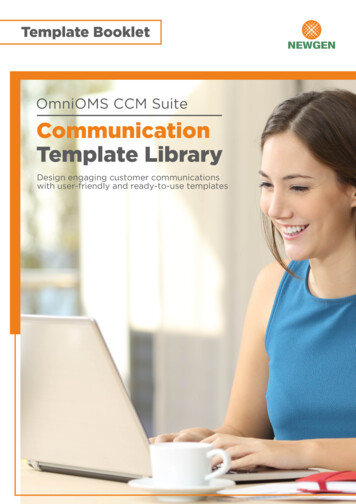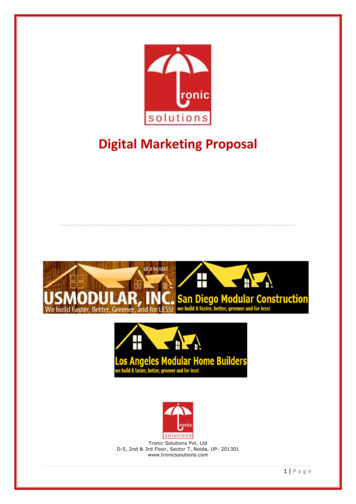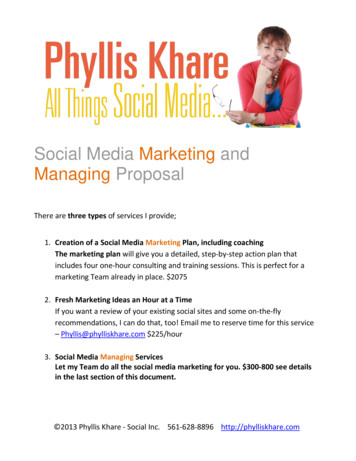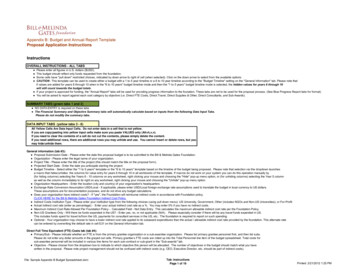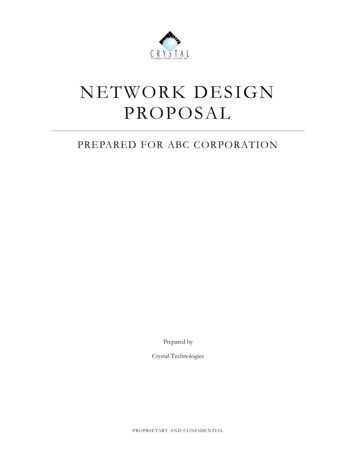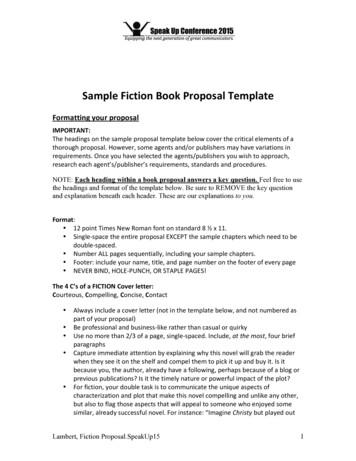
Transcription
: Each heading within a book proposal answers a key question. Feel free to usethe headings and format of the template below. Be sure to REMOVE the key questionand explanation beneath each header. These are our explanations to you.Format: 12pointTimesNewRomanfontonstandard8½x11. Single- ichneedtobedouble- ‐spaced. ters. terofeverypage NEVERBIND,HOLE- ter:Courteous,Compelling,Concise,Contact business- page,single- tybutplayedoutLambert, Fiction Proposal.SpeakUp151
l.Lambert, Fiction Proposal.SpeakUp152
[Sample cover page]A ProposalTitleSubtitleAuthorContact Information:[If agented, use agent’s contact info only]Author NameAddressAddressEmailPhones: home/office/cell/faxLambert, Fiction Proposal.SpeakUp153
What is the “can’t-put-it-down” aspect of the story? What is the unique plot hook that will compel readers to keep turning pages?Readers always buy and read books because of some felt need, but in the case of fiction,that felt need is usually for a powerful story that will transport us out of our own lives andinto the lives of the characters, into their world, for the duration of the novel and leave uswishing it were longer. Does your story have unique and compelling aspects that willgrab the reader and not let go? Make sure the editor knows what those are right up front.Brief Description (One to two sentences) How is this book best described, in one or two sentences?Imagine yourself a writer for an Internet bookseller or a sales clerk in a bookstore. In oneor two sentences, entice a shopper to grasp the unique and compelling aspects of thisbook’s story. This is sometimes called the “pitch” or “elevator speech” and the goal is topresent the book in a nutshell. You want to leave the one who reads your proposalwanting to read the rest of the book to find out what happens. This section will be a toolfor the editor, too, when she tries to persuade others in the publishing house that this is abook they must publish.Overview (approximately 500 words) What’s the story?You’ve already revealed to the editor the book’s unique hook. Now give them the rest ofthe story—briefly. Don’t feel that you have to give a play-by-play of every subtle plottwist. Nor should you feel you have to actually reveal the ending—it’s OK to leave theeditor wanting to read the manuscript to find out. Stick with the big picture. Focus on thecharacters and their own personal developmental arc. After all, fiction is about character.What happens to your characters? Revealing that will tell the editor more about yourbook than a boring “this happens, and then this happens, and then ” And DON’T goover 500 words—fewer is better.Primary Audience Who is the core target audience for this book?Who is the dead-center target reader? Describe your “ideal” reader as specifically aspossible including, as appropriate, the following: age range, generational identity, lifestage, gender, marital status, parents, education level, spiritual state, professional or laystatus (leaders, teachers, counselors, professionals, housewives, blue collar workers),geographic location, specific life needs. NOTE: If you identify a male target audience,you’d better explain in this section or the next one why women will buy your book too,either to read themselves or to give to their husbands and sons. Women are by far thedominant buyers of Christian books and also of fiction.Lambert, Fiction Proposal.SpeakUp154
Secondary Audience(s) Who, in addition to the target audience, might read or purchase this book?In addition to your core target audience, who might be the next most interested target(s)?Reader Benefits What specific benefits will the reader experience upon reading this book?Editors want to publish fiction that sells—in other words, they want to publish can’t-putdown fiction that generates great word of mouth. But they also want to publish fictionthat affects the reader’s life—that, in fact, changes lives. What are the specific lifebenefits your story might provide for your readers’ lives? In what ways might they neverbe the same after reading your story?Author Biography, Brief (one brief paragraph ideal for flap on book jacket)Describe your position, brand, expertise, and qualifications. Close with your city andstate and family. Example: Christina Doe resides in Minneapolis, MN with her husband,two children, and their Saint Bernard, Hugo.Author Biography (500 words or less, an expanded version of the above)Describe your position, brand, expertise, and qualifications. Include education, career,and life experiences that qualify you as a voice who has earned the right to be heard onthis topic.Author’s Writing Experience What previous writing experience (and audience) does the author have?Include all previously published work, magazines, newsletters, and professional papers.Include complete bibliographic information and sales or distribution numbers for each.Author’s Platform What audience reach does this author already have?Describe your platform (your exposure and interaction with audiences) such as media,speaking, teaching, social media (Facebook, Twitter, blogs, etc.). Include numbers ofpeople touched by each, speaking schedules, past media appearances and contacts,upcoming opportunities, etc. Why does this matter for a novelist? It matters becausetoday’s publishers don’t have the budget or manpower to do much to promote yourbook—you will have to do most of the promotion, whether for fiction or for nonfiction.And the publisher will want to know how well positioned you are to do it. Have anactive, well-read blog? Ten thousand followers on Twitter? Those things matter to apublisher.Lambert, Fiction Proposal.SpeakUp155
Unique Positioning among Competition in the Marketplace What other novels are written to this audience, and how does this book compare?Describe at least three (preferably five or six) other novels in the marketplace that aresimilar in nature or seek to reach the same general reader. Then for each, offer a fewsentences describing how your book is different from the competition.Include statistics and research that help quantify the reading audience or sales potential.For instance, if your main character is a woman struggling with a diagnosis of breastcancer, offer statistics on how many women are diagnosed with breast cancer each year.Unique Selling Proposition (USP) How is this book unique from every other book?Complete the following sentence:If (insert core audience) reads (insert title)Then (insert target audience) will experience (insert reader benefits)Because (describe HOW the book will accomplish its objectives).Example USP of a time management book for women:If women who feel overwhelmed by overly demanding lives and impossible to-do lists,read Escaping the Time Trap: 10 Strategies to Bring Balance to the OverwhelmedWomanThen they will discover effective strategies to prioritize their lives and successfullybalance the conflicting demands on their time,Because they will have been led through self-tests to discover their unique time traps andlearned proven and tested techniques to bring balance into their lives.It might seem like a stretch to create such a statement about a novel. After all, the mainselling point for fiction is that it’s a great story, powerfully told, that grabs hold of youand won’t let go until the last page. But I guarantee you that, even for fiction, Pub Boardswant such statements and use them in their selling presentations.Potential endorsers What endorsers are likely to recommend this book to their own readership andfollowing?List potential endorsers in approximate order of the breadth of their influence as far asyou know. If you already have relationships or connections with some well-knownendorsers, list those first and include comments about your connection.Lambert, Fiction Proposal.SpeakUp156
Marketing What ideas does the author have for marketing and promotion and how personallyinvested will he/she be spreading the word and capturing readers?How will you invest your time, energy, and funds in marketing? Be proactive. Bespecific.How will you and the publisher reach the intended audience? List networkingorganizations, magazines, associations, etc., that reach the same audience as your book.MUST INCLUDE your social media plan! List all social media in which you areinvolved (should be listed above in PLATFORM as well). Here you explain what yoursocial media promotional strategy will be.Length of manuscript How long will the book be?Give approximate word count range. (Note: Assume a rough estimate of 300 words perbound book page of completed book. Assume an average 12 point 8 ½ X 11 doublespaced MSS page is 250 words.)Manuscript completion time (length of time from contract to due date) When will the manuscript be completed?Common times given are anywhere from six to twelve months from contract, but this canvary greatly. If there is a unique reason for the book to release in a particular month (aconference, media opportunity, seasonal opportunity, etc.) mention that here as well.Keep in mind that once you’ve submitted your completed mss most traditional publisherswill require 9 to 12 months between manuscript due date and release month, as thisallows for editorial work, interior design, lead-time for selling to retailers, promotionplanning, PR, printing, and warehousing.Sample Chapters (3) (Double spaced)Include three sample chapters thato Cast the vision and scope of this booko Demonstrate the author’s best craft and skillFor a proposal for a novel, this is the most important part of the proposal by far. Manyeditors (including me!) will simply skip everything else and go straight to the samplechapters. If they like the chapters, they’ll look at the rest of the proposal. If they don’tlike the chapters, there’s no point in looking at the rest, because with fiction, the writingis everything. So make sure your sample chapters are compelling, that they show yourability, and that they present your story in a way that will leave the editor wanting to readmore. If your chapters aren’t yet up to that standard, then you aren’t ready to present yournovel to an editor.Lambert, Fiction Proposal.SpeakUp157
book’s story. This is sometimes called the “pitch” or “elevator speech” and the goal is to present the book in a nutshell. You want to leave the one who reads your proposal wanting to read the rest of the book to find out what happens. This section will be a tool
